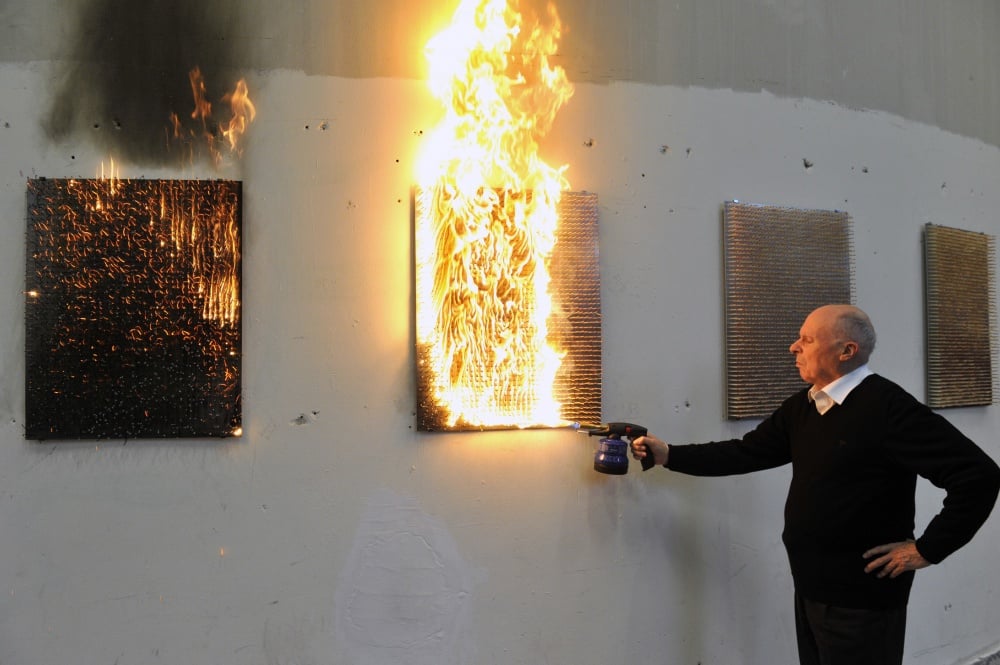
Bernard Aubertin, Fer Brûlé Nr.129(2010)
Photo: artnet
There’s only enough room for a finite number of artists on the radar of the contemporary art market at any one time. And due to the market’s obsession with the newest, youngest, and most exciting emerging artists, incredibly talented and accomplished artists can unfortunately be forced out to make way for the new.
Clever dealers often try to seek out these underrated “sleepers” to bring them to the market’s attention once again, often for substantial financial gains. Many of these artists played a role in forging crucial moments in art history, and while some of their contemporaries achieve sustained success, others often had to wait until the twilight of their careers to experience market validation. A handful of these prolific artists, unfortunately, don’t live long enough to enjoy the fruits of their life’s work.
Here we select eight of the most undervalued and underrated artists, whose market is poised for a surge. Each will doubtlessly experience a resurrection, it’s just a matter of time.
Billy Al Bengston Untitled (Dento) (N.D.)
Photo: Kayne Griffin Corcoran, Los Angeles
1. Billy Al Bengston (1934–): A key player of the legendary Ferus Gallery artists that defined the Los Angeles art scene in the 1960s and 1970s. Bengston pursued his artistic career whilst racing motorcycles professionally. His art is strongly influenced by West CoastPop and L.A. car culture and his works were included in the Getty Museum’s Pacific Standard Time retrospective of the California art scene. His market is showing signs of growth, as a work from 1961 recently sold for $75,000, more than double its pre-sale estimate.
Georg-Karl Pfahler S-GGGB (1968)
Photo: artnet
2. Georg-Karl Pfahler (1926–2002): One of the most influential German painters of the 1960s and 1970s, Pfahler was among the earliest proponents of the style of abstract, hard-edge, color-field painting that possesses a timeless quality. He represented Germany at the Venice Biennale in 1970, alongside Günther Uecker, Heinz Mack, and Thomas Lenk, but while his ZERO group contemporaries blossomed, Pfahler is still waiting to be rediscovered by the market.
Bernard Aubertin performing Tableau Feu (2012) at Palais de Tokyo, Paris
Photo: Didier Plowy via Palais de Tokyo
3. Bernard Aubertin (1934–2015): The French ZERO group artist was known for his monochrome red paintings and for the use of fire in his work, that created unique scorched surfaces, and which he exhibited in daring performances. His work was included in the Guggenheim Museum’s survey of the ZERO movement in 2014.
Agustín Cárdenas Bouba (1974-75)
Photo: Galeria Marc Domènech
4. Agustín Cárdenas (1927–2001): The surrealist sculptor was influenced by the work of Jean Arp and Constantin Brancusi. He expressed his Afro-Cuban heritage through charred wood sculpture recalling the forms of African and Polynesian art. While he enjoys a steady following in Paris and Latin America, the artist has not broken into the all-important American or UK markets yet. However, there will be a curated auction of his work on November 30 at FAAM – Fine Art Auctions Miami.
Mario Nigro Contestazione in Piazza (1969)
Photo: Farsetti Arte
5. Mario Nigro (1917–1992): A pharmacist, Nigro started painting as a hobby and based his abstract work on his scientific background. He had his first solo show in Milan in 1949 where he was introduced to Lucio Fontana. In 1958, Nigro devoted himself to painting and enjoyed due success, representing Italy at the 1968 Venice Biennale. Highly valued by dealers and collectors for decades, he never really broke into the mainstream consciousness of the art world.
Rose Wylie Three Halloween Chocs (2014)
Photo: VeneKlasen/Werner, Berlin
6. Rose Wylie (1934–): The 80-year-old British painter put her art ambitions aside to raise three children before graduating from the Royal College of Art in 1981. After decades of obscurity, her cartoonish and childlike paintings that recall the work of Philip Guston started attracting attention and were included in London’s Royal Academy group show this summer. She presents new works at Michael Werner’s Berlin space VeneKlasen/Werner on November 14.
Sérgio de Camargo Untitled (1964)
Photo: Estate of Sérigio de Camargo via Apollo Magazine
7. Sérgio de Camargo (1930–1990): Born in 1930, Camargo studied under Lucio Fontana in Brazil before completing his studies. Throughout the 1950s he collaborated with other Brazilian artists such as Lygia Clark and Mira Schendel. In the sixties, he returned to Paris where he experienced the greatest successes in his career. His works were included at the 1965 São Paolo Biennale, the 1966 Venice Biennale, and Documenta 4 in 1968. While his early work has peaked at around $2.2 million, seminal late pieces can still be bought for as little as $30,000.
Sam Gilliam Swing Sketch (1968)
Photo: David Kordansky Gallery, Los Angeles
8. Sam Gilliam (1933–): Some may argue that Gilliam’s market rediscovery is already in full swing. Nevertheless his inclusion is warranted as an example for how quickly a “forgotten” artist can be rediscovered. In the 1960s and 1970s, Gilliam became known for his “drape paintings,” large colorful canvases tied into knots and hung from the wall. He was celebrated as a painter who broke out of the frame, and had shows at the Whitney in 1969, MoMA in 1971 and the American Pavilion at the Venice Biennale in 1972. He was cut off from the art market for decades until dealer David Kordansky and artist Rashid Johnson curated a show in Los Angeles in 2013 that helped bring him back into the market’s consciousness.